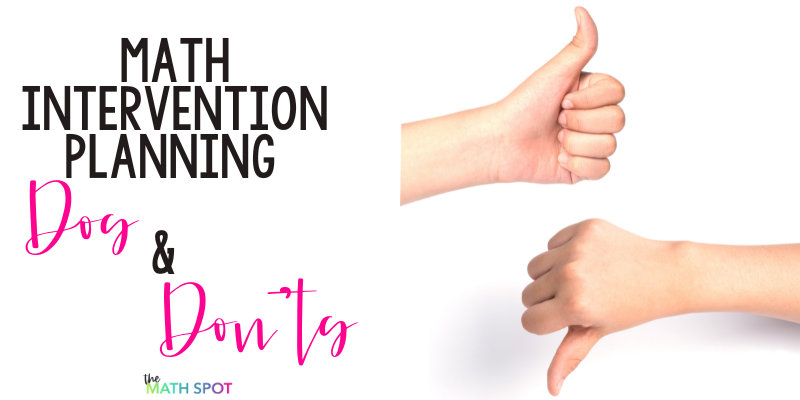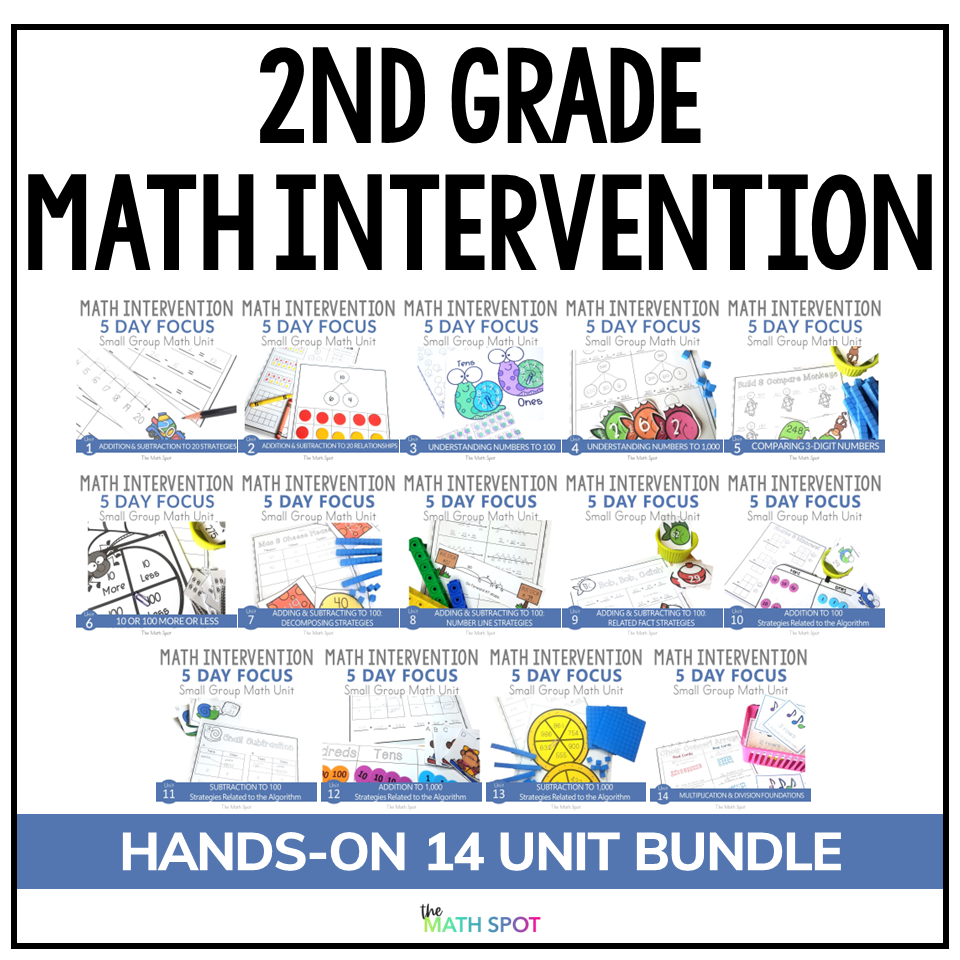This post contains affiliate links. This means that when you make a purchase, at no additional cost to you, I will earn a small commission.
Math intervention planning is a delicate balance between providing your students the time and space they need to understand while also moving with a sense of speed and purpose because you are aiming to close gaps. These tips will help you to accomplish that balance in your math intervention planning.

Do Start With Assessment… But Don’t Wait Too Long For the *Perfect* Assessment to Come Along
Your math intervention planning absolutely must start with assessment. Assessment allows you to determine exactly what your students already know and are able to do so that you can start their instruction with exactly the right next step.
Keep your assessment focused on the information you need now and information that will help you to guide your instruction. It can be tempting to look for and administer an assessment that addresses every standard at your grade level but this isn’t necessarily helpful when it comes to supporting your students and these assessments tend to take a long time to administer!
Instead, focus on assessments that help you to understand what range of numbers your students understand and what they know about how operations work and strategies to solve. Numbers and operations should be at the heart of your math intervention instruction so they need to be at the heart of your math intervention assessment as well.
This blog post explains exactly the type of assessment data you will need to get the year started and this blog post explains how you can keep it organized along the way.
Do Incorporate Long-Term Math Intervention Planning… But Don’t Forget To Leave Blank Space
You need a long-term plan for what you hope to accomplish with your students during the school year. If you lack long-term goals it is easy to get stuck in the mud of a specific skill or strategy. Keep up your sense of urgency by constantly having specific and targeted goals you are working on with your students.
At the same time, you want to be intentional about creating a long-term plan that includes plenty of time and space for practice and remediation. Your students will not all progress at the same time so having time built in to provide additional time and attention will allow you to support all of your students while still staying on track.
This blog post explains how you can create a plan for the year that includes long-term goals while also reserving time for practice.
Do Care About Fluency… But Don’t Let It Slow You Down!
You could easily get stuck for months and months, for example, composing and decomposing numbers to 10. Easily. This skill takes time, repeated exposures and repeated practice to master.
When you are thinking about your math intervention planning strategy, consider which skills can be explored, understood, and moved on from as opposed to the skills that will take additional practice and review until your students will become fluent.
For skills that require additional time and practice, think about how you might incorporate this practice without allowing it to consume the entirety of your intervention period.
For example, having automaticity with the partners of ten unlocks addition and subtraction strategies for your students that allow them to be more fluent when problem-solving. The problem with the partners of ten is that, for some students, it can take time for these facts to become automatic.
My strategy was to start off with a partners of ten unit. We explored partners of 10 using a variety of hands-on methods (red and yellow disks, using a rekenrek, using students’ own 10 fingers, etc.) After that initial unit, I assessed where my students were and, as long as they had an understanding of the partners of ten and weren’t completely in the weeds, I moved on.
My independent practice activities from that unit, however, didn’t go away! I had plenty of options for repeated exposure:
- As students enter the room have a practice activity available.
- Practice activities were available for early finishers during other activities.
- Add the activities into the rotation as an option during buffer weeks
- Leave lessons and activities from that unit for substitute teachers.
Do Look To Your Grade Level Standards… But Don’t Give All Standards the Same Attention
Math Intervention needs to focus on understanding of whole numbers including place value and operations.
Are other standards and skills important? Sure. But whole numbers (and in the upper-grade levels fractions and decimals) are the MOST important.
What you can do is work other standards into your numbers and operations instruction.

For example, at the 3rd grade level I probably wouldn’t want to spend a long period of time on creating and reading graphs. I will get more “bang for my buck” with my students in studying numbers and operations. But I still think graphing skills are important!
I created a unit about comparison word problems (an operations topic that is often very difficult for students!) that comes from the lens of graphing and data standards.
In this case, my students are practicing comparision relationships *while* interpreting the data in a bar graph.
It lends context and even engagement to this word problem type while also targeting a math skill that I wouldn’t want to spare time to in isolation.
Do Use Hands-On Tools… But Don’t Forget To Take Them Away!
When you are sitting down for math intervention planning you are right to start with math manipulatives, however, for each skill you are teaching you want to remember the end goal of that skill and standard.
There are certainly standards that state explicitly “Using objects or drawings” and, in those cases, it’s perfectly find that your students are relying on a hands-on tool to solve or demonstrate understanding of a math skill.
There are plenty of other math standards that don’t use this language! These standards might use language like “using strategies based on place value” or “using drawings and equations” or even “Fluently solve”.
Know the end point for the standards you are working toward and then be conscious in your math intervention planning of the appropriate end goal for your students.
Use the strategy of building a web (not a ladder) to start with hands-on tools but ultimately move your students to representational models and abstract thinking as well.







